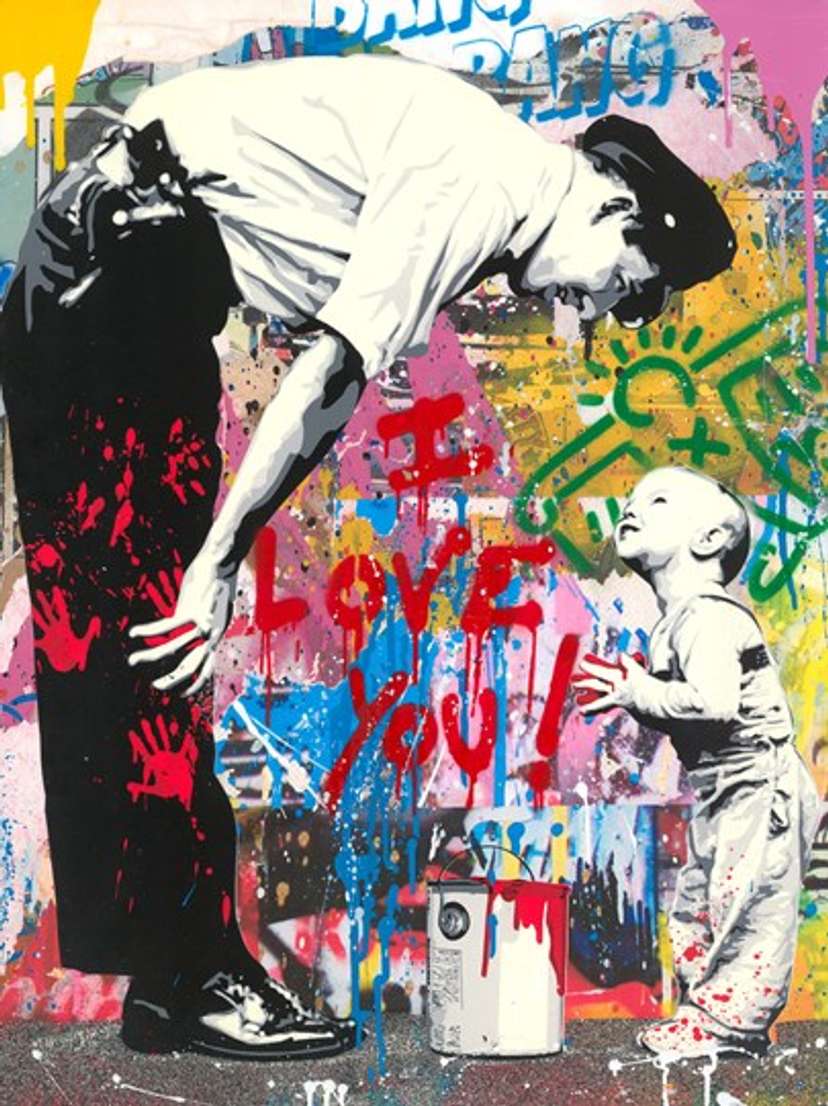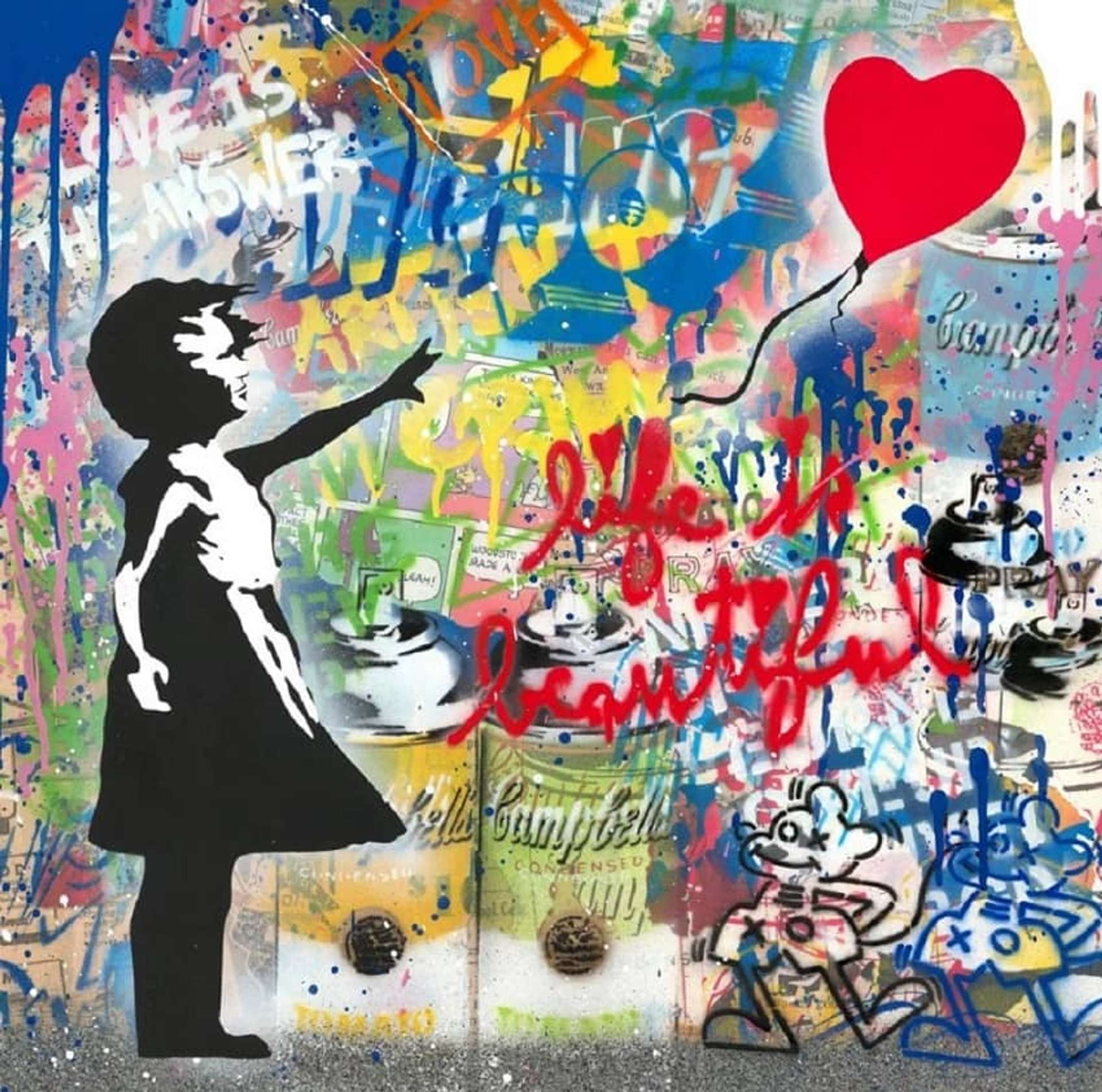From Banksy Protégé to Art World Sensation: Mr. Brainwash's Journey
 Image © Phillips / Star Wars Reunion © Mr. Brainwash 2010
Image © Phillips / Star Wars Reunion © Mr. Brainwash 2010
Mr Brainwash
27 works
”Art is freedom and you can do it any way you want. I can take a bottle and put it on top of this table and say this is art. If I believe it, it’s art for me, and it can be art for other people.’’ - Mr. Brainwash
The Creation of Mr. Brainwash: Banksy's Role and the Controversy Surrounding It
One of the most controversial and intriguing figures in contemporary art is Mr. Brainwash, whose identity and authenticity as an artist have been hotly debated. Some critics have accused him of being a mere fabrication created by the elusive street artist Banksy, while others view him as a genuine artistic talent in his own right.
Banksy's involvement in Mr. Brainwash's rise to fame has sparked various interpretations and debates. Some view it as a genuine act of support and mentorship, while others speculate that Banksy orchestrated the whole affair as an elaborate prank or social experiment. Regardless of Banksy's true intentions, his association with Mr. Brainwash undeniably played a significant role in propelling the latter's career.
Mr. Brainwash's early works showcased a style reminiscent of Banksy's signature stencils and provocative imagery. While similarities in technique and subject matter are evident, Mr. Brainwash's art also diverged with a distinct pop art influence and an emphasis on bold colours and mixed media.
 Balloon Girl © Mr. Brainwash 2019
Balloon Girl © Mr. Brainwash 2019Mr. Brainwash's Art Philosophy and Inspiration
At the heart of Mr. Brainwash's art lies a vision that aims to challenge conventional notions of creativity and blur the lines between art and commerce. In interviews, he often speaks about his mission to inspire and uplift through his work, encouraging viewers to question societal norms and embrace the power of self-expression. Drawing inspiration from various sources, Mr. Brainwash's art incorporates elements of pop culture, history, and personal experiences. His eclectic mix of influences is evident in his vibrant and energetic pieces, which often feature iconic figures, historical events, and familiar symbols.
Mr. Brainwash's style and techniques showcase a fusion of originality and appropriation. He employs stencilling, collage, and bold use of colours to create visually striking compositions. While critics have questioned the originality of his work, there is no denying the creativity in his ability to transform everyday objects and images into thought-provoking artworks.
Compared to contemporary artists, including Shepard Fairey and Damien Hirst, Mr. Brainwash stands apart for his unapologetic approach to blending art and commercialism. His art challenges traditional boundaries and embraces the accessibility of mass media and consumer culture.
 Kate Moss © Mr. Brainwash 2018
Kate Moss © Mr. Brainwash 2018Exit Through the Gift Shop: A Riddle, an Enigma, or a Documentary?
Exit Through the Gift Shop is a documentary film directed by Banksy that follows the journey of an eccentric Frenchman named Thierry Guetta, also known as Mr. Brainwash, as he becomes embroiled in the world of street art.
The film's message and genre have been widely debated, with some viewing it as a satire of the art world, a hoax or even a critique of the very culture it portrays. Its structure, which blurs the line between documentary and fiction, adds to the intrigue and mystery surrounding the film. Mr. Brainwash's role in the film is multifaceted, serving as both a subject and a collaborator to Banksy. However, his meteoric rise to fame and the authenticity of his art have been heavily scrutinised, with many questioning whether his art is a legitimate expression of creativity or simply a commercial product.
Despite these controversies, the film's impact and legacy on the art world and the public perception of street art have been significant. It has sparked new conversations about the value of art and the role of authenticity in an increasingly commercialised art world. Exit Through the Gift Shop remains a riddle, an enigma, and a fascinating exploration of the world of street art and the individuals who inhabit it.
 Tomato Spray © Mr. Brainwash 2008
Tomato Spray © Mr. Brainwash 2008Mr. Brainwash's Journey to Fame: From Obscurity to Sensation
The ascent of Mr. Brainwash from relative obscurity to art world sensation has been a remarkable trajectory. His journey began as a videographer, capturing the thriving street art scene in Los Angeles. Inspired by the artists he documented, he embarked on his own artistic path, eventually gaining recognition and acclaim.
Over the course of his career, Mr. Brainwash collaborated with high-profile celebrities such as Madonna and the Red Hot Chili Peppers. It employed savvy marketing tactics to promote himself and his art. These included viral marketing campaigns, celebrity endorsements, and media exposure, which helped increase his profile and attract a wider audience.
However, Mr. Brainwash's rise to fame was not without controversy. As a self-taught artist, he faced accusations of plagiarism and commercialism, with some critics claiming that he lacked authenticity and originality. Despite these challenges, Mr. Brainwash's success story remains significant and relevant to the art world and cultural landscape. His dynamic journey reflects the power of self-promotion and the importance of branding in today's media-saturated society. His work and career have also sparked important conversations about the nature of art and the role of self-expression in an increasingly commodified world.
The Making of Exit Through the Gift Shop: Storyboard, Awards, and Promos
Exit Through the Gift Shop was a collaborative effort that involved Banksy, producer Jaimie D'Cruz, editor Chris King, and a team of cameramen and animators. According to interviews and sources, the film was shot over several years in different locations around the world, with Banksy directing and narrating the story.
One of the unique aspects of the film was its non-linear and self-reflexive structure, which challenged traditional documentary conventions and blurred the boundaries between reality and fiction. This approach was reflected in the film's editing, soundtrack, and animation, which combined humour, irony, and suspense. Exit Through the Gift Shop received critical acclaim and numerous awards and nominations, including the Academy Award for Best Documentary Feature in 2011. The film also generated buzz and curiosity through unconventional marketing campaigns, such as the mysterious billboards and the limited-release strategy.
The making of Exit Through the Gift Shop was a testament to Banksy's creative vision and storytelling skills, as well as the hard work and talent of the film crew. It remains a landmark in the history of street art and documentary filmmaking.
Mr. Brainwash's New York Exhibition: Over-the-Top and Unapologetic
Mr. Brainwash's latest New York exhibition, Life is Beautiful, made a splash in the art world, garnering attention from critics and audiences. The exhibition embraced an over-the-top and unapologetic style, which has become synonymous with Mr. Brainwash's work and persona.
Within the exhibition, Mr. Brainwash explored recurring themes of love, hope, and resilience, using his signature blend of stencilling, collage, and mixed media. The works were characterised by vibrant colours, bold typography, and larger-than-life installations. The artistic and commercial value of Mr. Brainwash's works remained a subject of debate. While his art embraced mass appeal and accessibility, critics questioned the depth and originality of his creative vision. Comparisons were drawn between his recent works and earlier pieces, as well as with other contemporary artists, examining their stylistic evolution and thematic exploration. The exhibition further ignited controversies with accusations of plagiarism and debates around the commodification of street art. Some argued that Mr. Brainwash's use of appropriated images and commercial collaborations compromised the integrity of his work.
Regardless of the debates and criticisms, Mr. Brainwash's New York exhibition made a significant impact, stimulating dialogue about the boundaries and commercialisation of street art. Its over-the-top and defiant approach ensured the show was not easily ignored, leaving a lasting impression on both the art world and the general public.
 Diamond Girl Red © Mr. Brainwash 2016
Diamond Girl Red © Mr. Brainwash 2016Mr. Brainwash's Artistic Process: Techniques, Materials, and Themes
Mr. Brainwash's artistic process is a dynamic and multi-layered journey that begins with conception and culminates in the execution of his works. He combines various techniques and materials to create his signature style, characterised by a vibrant blend of stencilling, spray painting, and collage.
Using stencilling as a foundation, Mr. Brainwash employs spray painting, brushwork, and collage to layer his compositions. The juxtaposition of bold colours, iconic figures, and pop culture references is a hallmark of his work, often conveying political or social messages. Themes explored by Mr. Brainwash encompass a wide range of subjects, including love, freedom, and consumerism. His works often challenge societal norms and present an optimistic view of the world, while simultaneously critiquing the forces that shape it.
While Mr. Brainwash's style has garnered both acclaim and criticism, it undeniably possesses strengths and weaknesses. The use of bold colours, larger-than-life installations, and mixed media techniques contribute to the immediate impact of his works. However, some critics argue that his style lacks originality and depth, as it often appropriates imagery and relies heavily on established cultural references.
Examples of Mr. Brainwash's works, such as his reinterpretation of famous album covers or his larger-than-life installations, provide insight into his artistic process and vision.
The Message of Exit Through the Gift Shop: Authenticity, Irony, and Critique
Exit Through the Gift Shop offers a multi-layered and thought-provoking message that invites interpretation and debate.
Interpretations of the film's message vary, with some viewing it as a scathing critique of the art world's commercialisation and hype. In contrast, others see it as a celebration of the DIY spirit and the power of self-expression. Additionally, the film exposes the media manipulation and sensationalism surrounding the art market. Irony, humour, and satire play significant roles in the film, challenging viewers' perceptions and engaging them in a critical reflection of art and its commodification. These elements amplify the film's impact and underscore the tension between authenticity and artifice. Exit Through the Gift Shop also raises ethical and aesthetic questions, prompting discussions about the role of the artist in society and the blurred boundaries between art and commerce.
In a broader context, the film's message resonates with cultural and political issues of our time, including consumerism, globalisation, and social justice. Ultimately, the message of Exit Through the Gift Shop remains open to interpretation, inviting viewers to delve into the complexities of the art world, challenge societal norms, and critically reflect on the intersection of art, commerce, and media.
 Follow Your Dream © Mr. Brainwash 2008
Follow Your Dream © Mr. Brainwash 2008Mr. Brainwash's Legacy and Influence: From Street Art to Pop Art
Mr. Brainwash has left a lasting mark on the art world and popular culture, with his art and celebrity persona attracting widespread recognition and influencing subsequent generations of artists. His impact can be seen in the realm of street art and beyond.
Drawing inspiration from contemporary and urban artists such as Andy Warhol, Jean-Michel Basquiat, and Shepard Fairey, Mr. Brainwash has emerged as a competitive force in the world of pop art. His fusion of street art aesthetics with bold and iconic imagery has garnered attention and sparked conversations about the intersection of high and low culture. Assessing his legacy and influence, his strengths lie in his ability to generate widespread appeal and challenge traditional artistic boundaries.
Looking forward, Mr. Brainwash's legacy and influence carry significance for the future of art and culture. His ability to bridge the gap between street art and mainstream acceptance has opened doors for emerging artists and paved the way for a more inclusive and accessible art world.












